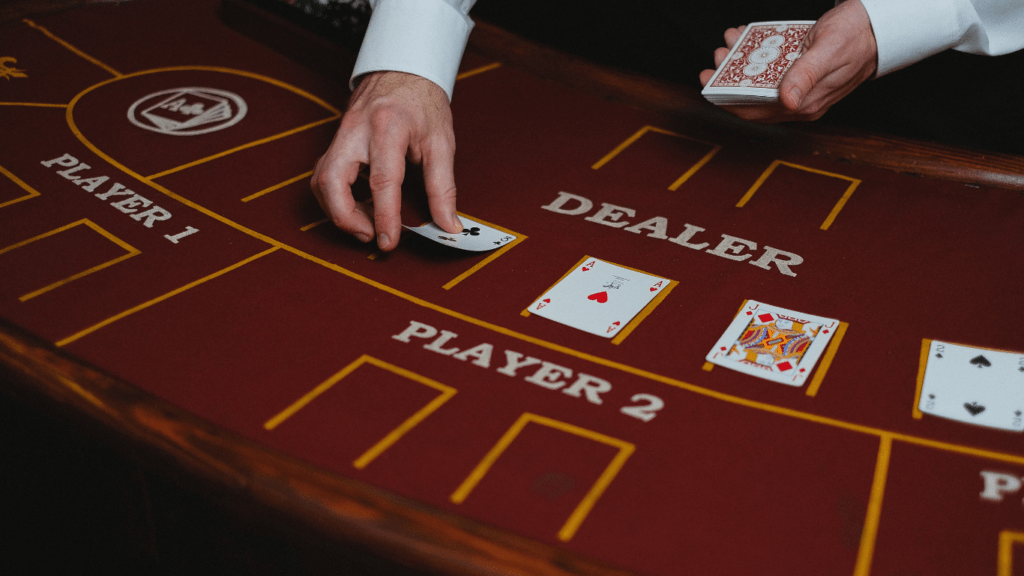The Origins of Blackjack
Blackjack, a classic card game, traces its beginnings to 17th-century Europe. Its origins are rooted deeply in several early gambling traditions.
Early Beginnings
In the early days, a game called “Vingt-et-Un,” meaning “Twenty-One,” emerged in French casinos around 1700. Players aimed to reach 21 without exceeding it, using strategies to outplay opponents. This game gained popularity quickly and spread to other European regions.
Influences from European Games
Several European games influenced blackjack’s development. One key predecessor, the Spanish game “Trenta y Uno,” required players to reach 31 with a minimum of three cards.
Additionally, the Italian game “Seven and a Half” focused on achieving 7.5 points using face cards and sevens, avoiding busts. These games contributed various elements to what would become modern blackjack.
Blackjack in the American Context
Blackjack’s journey to the United States marked a significant chapter in its history, shaping its modern form and popularity.
Arrival in the United States
Blackjack arrived in the United States in the early 1800s through French colonists. The game was introduced to the general populace via gambling establishments in New Orleans.
These early American settings contributed to rule refinements and name changes. For instance, when gambling houses offered a 10-to-1 payout for a hand containing the Ace of Spades and a black Jack, the term “blackjack” emerged.
Evolution and Popularization
Throughout the 19th and 20th centuries, blackjack evolved due to its inclusion in Nevada’s legalized gaming industry in 1931. Nevada’s legalization acted as a catalyst, propelling blackjack’s growth in casinos.
Key gameplay standards, such as the dealer standing on 17 or higher, formed during this period. By the mid-20th century, blackjack gained further traction due to strategic card counting, popularized by Edward O.
Thorp’s book “Beat the Dealer.” This pivotal work brought significant attention to blackjack strategies and increased player interest, cementing its reputation as a skill-based game.
The American context played a crucial role in transforming blackjack from a simple card game into a strategic casino staple, influencing both its rules and widespread appeal.
The Role of Casinos

Casinos propelled blackjack from a local game to an international sensation. Their influence now shapes in such:
- gameplay mechanic
- regulations
- variations
Adoption by Major Casinos
In the early 20th century, major casinos recognized blackjack’s potential. As the first legalized gaming houses in Nevada opened in 1931, they prominently featured blackjack, ensuring it attracted gamblers. Notably, Las Vegas casinos refined blackjack rules to enhance player experience. For instance, they standardized the 3:2 payout for getting a natural blackjack, which quickly became the industry norm.
Impact on Game Variations
Casinos greatly influenced blackjack’s evolution. They introduced many variations to maintain player interest. For example, Atlantic City casinos popularized Spanish 21, which uses a deck without 10-spot cards.
Meanwhile, Las Vegas establishments introduced Double Exposure, where both dealer cards are revealed. Each variation added unique twists to the game, allowing casinos to cater to diverse player preferences.
Legal and Cultural Milestones
Throughout its history, blackjack has achieved significant legal and cultural milestones, shaping its status in the gaming world and influencing global casino culture.
Legalization and Regulation
Blackjack’s legalization significantly impacted its popularity. Nevada took the lead by legalizing gambling in 1931, allowing blackjack to flourish in Las Vegas casinos. The Nevada Gaming Control Board established strict regulations to ensure fair play and secure environments.
The Indian Gaming Regulatory Act of 1988 allowed Native American tribes to operate casinos, leading to a surge in blackjack’s popularity across the United States. This act created new opportunities for legalized gambling and spurred the growth of tribal casinos.
Internationally, the United Kingdom legalized casinos in 1968 through the Gaming Act, which regulated and legitimized blackjack and other casino games. This act paved the way for modern gaming establishments and ensured a regulated environment.
Cultural Representation
Blackjack’s cultural representation in media and literature has bolstered its iconic status. Films like “21” (2008) and “Rain Man” (1988) showcased blackjack, highlighting its strategic depth and appeal. These films brought blackjack into the mainstream, attracting new players and popularizing card counting techniques.
Literature has also played a role. Edward O. Thorp’s “Beat the Dealer” (1962) had a profound impact, providing insights into card counting and enhancing blackjack’s reputation as a game of skill. This book reached a broad audience, cementing blackjack’s place in popular culture.
Television shows like “Las Vegas” and “Breaking Vegas” helped familiarize audiences with blackjack, displaying high-stakes play and the glamorous casino environment. These shows contributed to blackjack’s allure and helped sustain its popularity in modern culture.
The Digital Age of Blackjack
Technological advances transformed how people engage with blackjack. With online casinos and mobile gaming, the game reached new heights of accessibility and popularity.
Online Casinos
- Online casinos revolutionized the way players access blackjack.
- The first online casinos emerged in the mid-1990s, offering live and RNG (Random Number Generator) blackjack games.
- Reputable platforms like Bet365 and 888casino provide various blackjack variants, including classic, multi-hand, and live dealer games.
- These online platforms introduced new features, such as leaderboards and tournaments, that enhanced the competitive aspect of the game.
- Secure payment methods and advancements in encryption technology ensured safe and fair play, contributing to the rapid growth of online blackjack.
Mobile Gaming Influence
Mobile gaming extended blackjack’s reach further. With the advent of smartphones and tablets, blackjack became accessible anytime, anywhere.
Leading software developers like NetEnt and Microgaming optimized blackjack games for mobile devices, ensuring smooth gameplay and intuitive interfaces.
Popular apps like Zynga Poker and Blackjack 21 offer free and paid versions, attracting a diverse audience. Mobile gaming supports real-time multiplayer modes, enabling players to compete against each other globally. This convenience and versatility contribute significantly to modern blackjack’s widespread appeal.

